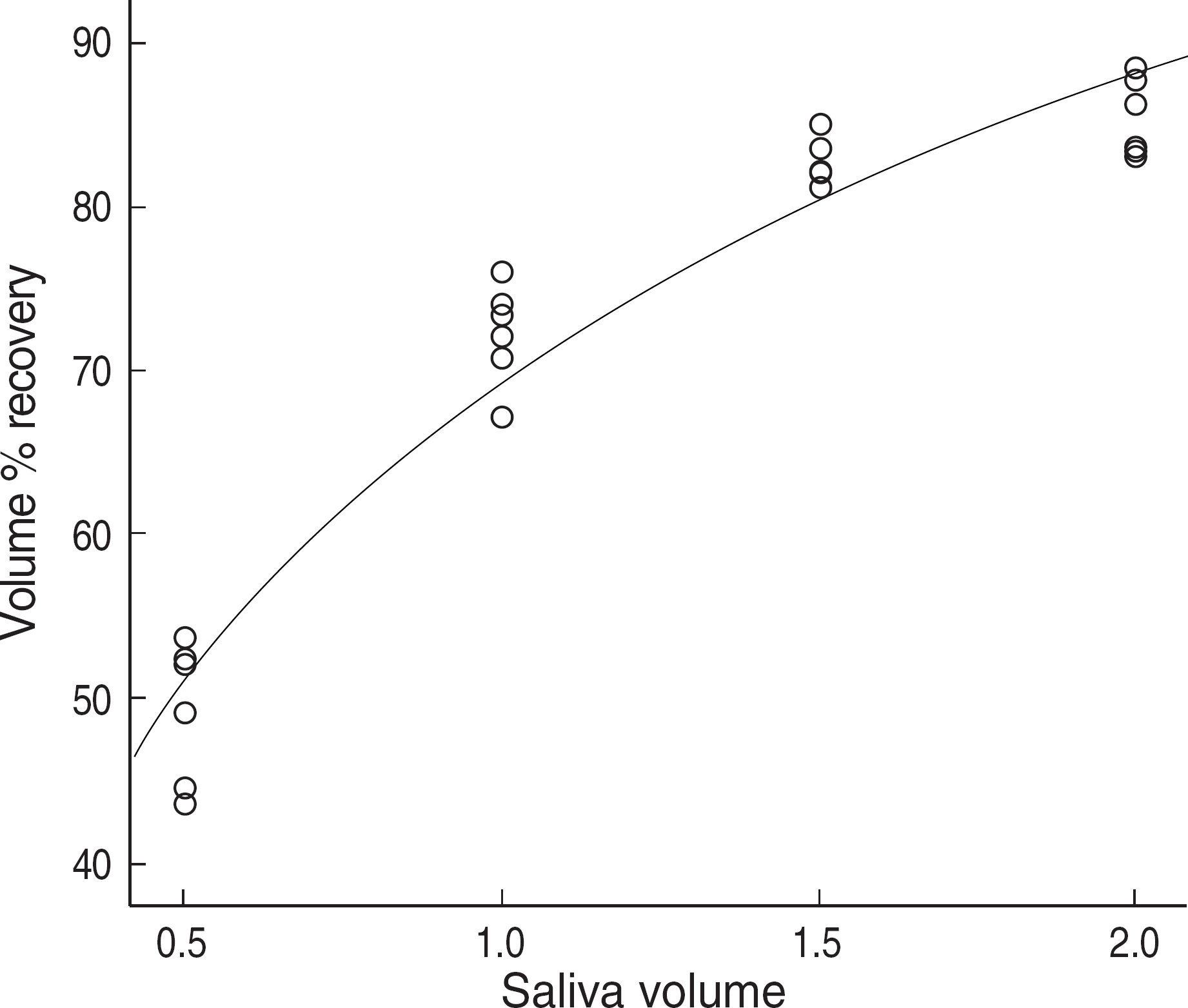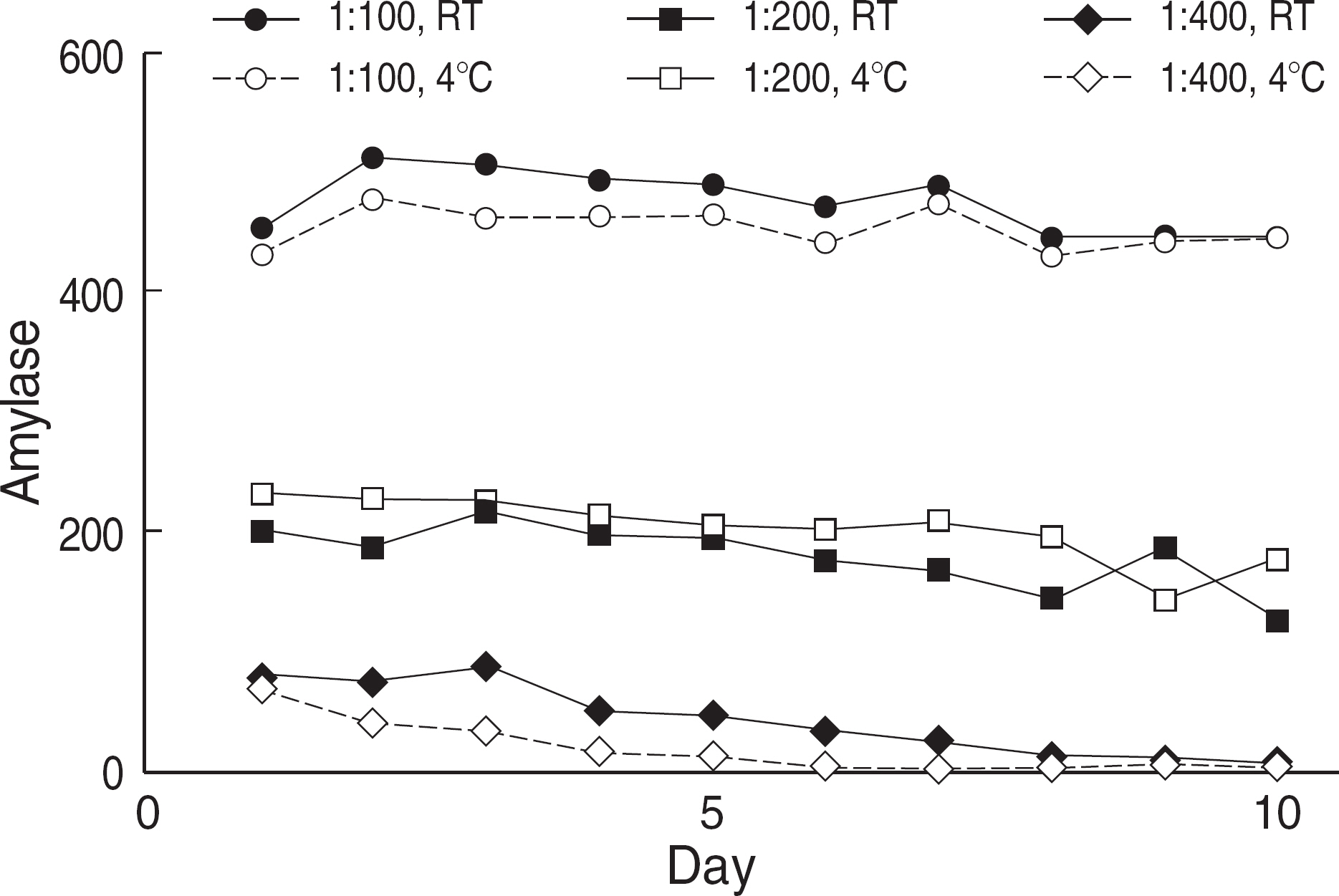Korean J Lab Med.
2008 Dec;28(6):438-443. 10.3343/kjlm.2008.28.6.438.
Measurement of Amylase in Saliva Collected by Salivette
- Affiliations
-
- 1Department of Clinical Pathology, School of Medicine, Kyungpook National University, Daegu, Korea. kesong@knu.ac.kr
- 2Department of Psychiatry, School of Medicine, Kyungpook National University, Daegu, Korea.
- KMID: 1781578
- DOI: http://doi.org/10.3343/kjlm.2008.28.6.438
Abstract
- BACKGROUND
Saliva is increasingly being used as a specimen for systemic disease as well as for oral health status. Especially, salivary amylase has been studied as an excellent index for psychological stress. Authors evaluated the measurement of salivary amylase activities collected by Salivettes (Sarstedt, Germany). METHODS: Saliva specimens were collected from 13 healthy adults between 10:00 and 11:00 a.m. Participants were asked to gently chew tampons of Salivettes for 1 min. Immediately after collection, all specimens were stored frozen. On the day of testing, they were centrifuged after thawing and diluted with distilled water. Amylase was measured by Dimension RxL Max (Dade Behring Inc., USA). We evaluated precision, linearity, and recovery rate of Salivette. Amylase activities between collection of saliva by Salivette and passive drool were compared, and also the changes of amylase by the storage temperature were evaluated. RESULTS: Intra-run CVs for three levels of amylase were excellent. Between-day CVs and total CVs were good only for mid and high levels. A good linear relationship was found at all diluted levels. Dosing Salivettes with 2 mL, 1.5 mL, and 1 mL yielded sample recovery 85.5+/-2.4%, 82.4+/-1.5%, and 72.2+/-3.1%, respectively and amylase recovery 78.9+/-10.9%, 74.1+/-13.7%, and 37.3+/-26.9%, respectively. Amylase by Salivette and passive drool were correlated well (r=0.757), although they showed a significant difference. Amylase activity was not affected by the storage temperature. CONCLUSIONS: Measurement of salivary amylase using Salivette could be a useful test having good intra-run CVs and linearity. More than 1.5 mL of saliva would be needed to have more than 70% recovery of Salivette.
MeSH Terms
Figure
Reference
-
1.Streckfus CF., Bigler LR. Saliva as a diagnostic fluid. Oral Dis. 2002. 8:69–76.
Article2.Lawrence HP. Salivary markers of systemic disease: noninvasive diagnosis of disease and monitoring of general health. J Can Dent Assoc. 2002. 68:170–4.3.Kaufman E., Lamster IB. The diagnostic applications of saliva–a review. Crit Rev Oral Biol Med. 2002. 13:197–212.4.Nater UM., Rohleder N., Gaab J., Berger S., Jud A., Kirschbaum C, et al. Human salivary alpha-amylase reactivity in a psychosocial stress paradigm. Int J Psychophysiol. 2005. 55:333–42.
Article5.Nater UM., La Marca R., Florin L., Moses A., Langhans W., Koller MM, et al. Stress-induced changes in human salivary alpha-amylase activity–associations with adrenergic activity. Psychoneuroendocrinology. 2006. 31:49–58.
Article6.Takai N., Yamaguchi M., Aragaki T., Eto K., Uchihashi K., Nishikawa Y. Effect of psychological stress on the salivary cortisol and amylase levels in healthy young adults. Arch Oral Biol. 2004. 49:963–8.
Article7.Gordis EB., Granger DA., Susman EJ., Trickett PK. Asymmetry between salivary cortisol and alpha-amylase reactivity to stress: relation to aggressive behavior in adolescents. Psychoneuroendocrinology. 2006. 31:976–87.8.van Stegeren A., Rohleder N., Everaerd W., Wolf OT. Salivary alpha amylase as marker for adrenergic activity during stress: effect of betablockade. Psychoneuroendocrinology. 2006. 31:137–41.
Article9.Granger DA., Kivlighan KT., el-Sheikh M., Gordis EB., Stroud LR. Salivary alpha-amylase in biobehavioral research: recent developments and applications. Ann N Y Acad Sci. 2007. 1098:122–44.10.Noto Y., Sato T., Kudo M., Kurata K., Hirota K. The relationship between salivary biomarkers and state-trait anxiety inventory score under mental arithmetic stress: a pilot study. Anesth Analg. 2005. 101:1873–6.
Article11.Ehlert U., Erni K., Hebisch G., Nater U. Salivary alpha-amylase levels after yohimbine challenge in healthy men. J Clin Endocrinol Metab. 2006. 91:5130–3.12.Chicharro JL., Lucia A., Perez M., Vaquero AF., Urena R. Saliva composition and exercise. Sports Med. 1998. 26:17–27.
Article13.Granger DA., Kivlighan KT., Fortunato C., Harmon AG., Hibel LC., Schwartz EB, et al. Integration of salivary biomarkers into developmental and behaviorally-oriented research: problems and solutions for collecting specimens. Physiol Behav. 2007. 92:583–90.
Article14.DeCaro JA. Methodological considerations in the use of salivary alpha-amylase as a stress marker in field research. Am J Hum Biol. 2008. 20:617–9.15.Harmon AG., Towe-Goodman NR., Fortunato CK., Granger DA. Differences in saliva collection location and disparities in baseline and diurnal rhythms of alpha-amylase: a preliminary note of caution. Horm Behav. 2008. 21.
Article16.Nater UM., Rohleder N., Schlotz W., Ehlert U., Kirschbaum C. Determinants of the diurnal course of salivary alpha-amylase. Psychoneuroendocrinology. 2007. 32:392–401.
Article17.Schirtcliff EA., Granger DA., Schwartz E., Curran MJ. Use of salivary biomarkers in biobehavioral research: cotton-based sample collection methods can interfere with salivary immunoassay results. Psychoneuroendocrinology. 2001. 26:165–73.18.Crouch DJ. Oral fluid collection: the neglected variable in oral fluid testing. Forensic Sci Int. 2005. 150:165–73.
Article19.Harmon AG., Hibel LC., Rumyantseva O., Granger DA. Measuring salivary cortisol in studies of child development: watch out–what goes in may not come out of saliva collection devices. Dev Psychobiol. 2007. 49:495–500.
Article20.Yamaguchi M., Kanemori T., Kanemaru M., Takai N., Mizuno Y., Yoshida H. Performance evaluation of salivary amylase activity monitor. Biosens Bioelectron. 2004. 20:491–7.
Article21.Yamaguchi Y., Deguchi M., Wakasugi J., Ono S., Takai N., Higashi T, et al. Hand-held monitor of sympathetic nervous system using salivary amylase activity and its validation by driver fatigue assessment. Biosens Bioelectron. 2006. 21:1007–14.
Article
- Full Text Links
- Actions
-
Cited
- CITED
-
- Close
- Share
- Similar articles
-
- Salivary secretion and salivary stress hormone level changes induced by tongue rotation exercise
- The relationship between the level of salivary alpha amylase activity and pain severity in patients with symptomatic irreversible pulpitis
- Salivary alpha-amylase as a stress biomarker in diseased dogs
- Comparison of Methods for Collecting Saliva for Pepsin Detection in Patients with Laryngopharyngeal Reflux
- Evaluation of the Reliability of Salivary Testing Instrument






